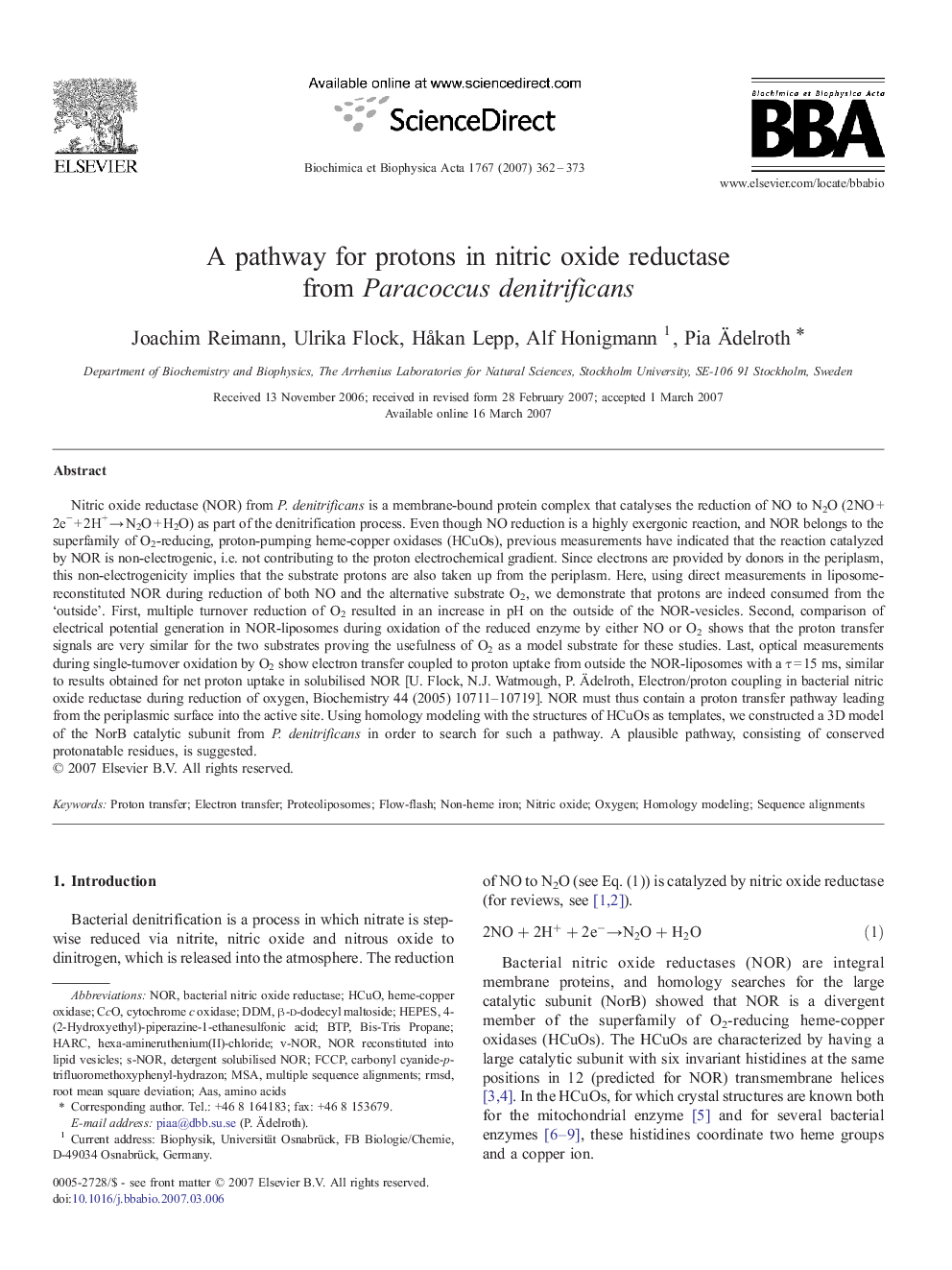| کد مقاله | کد نشریه | سال انتشار | مقاله انگلیسی | نسخه تمام متن |
|---|---|---|---|---|
| 1943507 | 1052670 | 2007 | 12 صفحه PDF | دانلود رایگان |
عنوان انگلیسی مقاله ISI
A pathway for protons in nitric oxide reductase from Paracoccus denitrificans
دانلود مقاله + سفارش ترجمه
دانلود مقاله ISI انگلیسی
رایگان برای ایرانیان
کلمات کلیدی
CCOBis-Tris PropaneHCuO4-(2-hydroxyethyl)-piperazine-1-ethanesulfonic acidBTPNORFCCPMSADDMHEPESRMSDAASAmino acids - اسید آمینه یا آمینو اسیدelectron transfer - انتقال الکترونProton transfer - انتقال پروتونOxygen - اکسیژنbacterial nitric oxide reductase - باکتری نیتریک اکسید ردوکتازMultiple sequence alignments - ترازهای توالی چندگانهSequence alignments - ترتیب توالیFlow-flash - جریان فلشcytochrome c oxidase - سیتوکروم سی اکسیدازNon-heme iron - غیر هام آهنHomology modeling - مدل سازی همگراroot mean square deviation - میانگین انحراف مربع ریشهNitric oxide - نیتریک اکسیدHeme-copper oxidase - هیدروژن اکسیداز مسProteoliposomes - پروتئولپوزوم ها
موضوعات مرتبط
علوم زیستی و بیوفناوری
علوم کشاورزی و بیولوژیک
دانش گیاه شناسی
پیش نمایش صفحه اول مقاله

چکیده انگلیسی
Nitric oxide reductase (NOR) from P. denitrificans is a membrane-bound protein complex that catalyses the reduction of NO to N2O (2NO + 2eâ + 2H+ â N2O + H2O) as part of the denitrification process. Even though NO reduction is a highly exergonic reaction, and NOR belongs to the superfamily of O2-reducing, proton-pumping heme-copper oxidases (HCuOs), previous measurements have indicated that the reaction catalyzed by NOR is non-electrogenic, i.e. not contributing to the proton electrochemical gradient. Since electrons are provided by donors in the periplasm, this non-electrogenicity implies that the substrate protons are also taken up from the periplasm. Here, using direct measurements in liposome-reconstituted NOR during reduction of both NO and the alternative substrate O2, we demonstrate that protons are indeed consumed from the 'outside'. First, multiple turnover reduction of O2 resulted in an increase in pH on the outside of the NOR-vesicles. Second, comparison of electrical potential generation in NOR-liposomes during oxidation of the reduced enzyme by either NO or O2 shows that the proton transfer signals are very similar for the two substrates proving the usefulness of O2 as a model substrate for these studies. Last, optical measurements during single-turnover oxidation by O2 show electron transfer coupled to proton uptake from outside the NOR-liposomes with a Ï = 15 ms, similar to results obtained for net proton uptake in solubilised NOR [U. Flock, N.J. Watmough, P. Ãdelroth, Electron/proton coupling in bacterial nitric oxide reductase during reduction of oxygen, Biochemistry 44 (2005) 10711-10719]. NOR must thus contain a proton transfer pathway leading from the periplasmic surface into the active site. Using homology modeling with the structures of HCuOs as templates, we constructed a 3D model of the NorB catalytic subunit from P. denitrificans in order to search for such a pathway. A plausible pathway, consisting of conserved protonatable residues, is suggested.
ناشر
Database: Elsevier - ScienceDirect (ساینس دایرکت)
Journal: Biochimica et Biophysica Acta (BBA) - Bioenergetics - Volume 1767, Issue 5, May 2007, Pages 362-373
Journal: Biochimica et Biophysica Acta (BBA) - Bioenergetics - Volume 1767, Issue 5, May 2007, Pages 362-373
نویسندگان
Joachim Reimann, Ulrika Flock, HÃ¥kan Lepp, Alf Honigmann, Pia Ãdelroth,